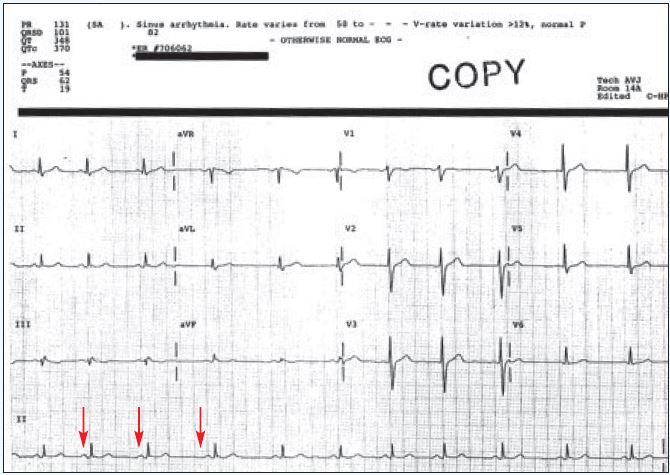Published on
The Resolution
Differential Diagnosis
- Sinus tachycardia
- Supraventricular tachycardia
- Atrial fibrillation
- Multifocal atrial tachycardia
- Sinus arrhythmia
Diagnosis
The ECG revels sinus arrhythmia, with “p” waves preceding each QRS, excluding atrial fibrillation. The rate is between 60-100, so this is not a tachycardic ECG (excluding MAT, SVT or sinus tachycardia). The PR and QRS intervals are normal, arguing against a bundle branch block or a ventricular rhythm. There are no ischemic changes suggestion of acute coronary syndrome (no ischemic ST changes or abnormal T wave inversions).
Learnings
- Sinus arrhythmia is common in young patients and is a normal physiologic response, typically due to increased or decreased vagal tone during breathing (inspiration decreases the vagal tone, causing an increase in the heart rate)
- This is a benign rhythm that sometimes will be appreciated by the patient and other times may be asymptomatic
- The complaint of palpitations is common, and a history should be taken looking for electrolyte abnormalities, ischemia, SVT, drug use, and medication interactions/effects.
- If the history is not suggestive or concerning for a serious underlying problem, lab testing is not required
Pearls for Initial Management and Considerations for Transfer
- Although a sinus arrhythmia is a benign rhythm, the patient should be questioned for a serious underlying cause
- If the rhythm is found incidentally and the patient is asymptomatic/without new symptoms, no further testing is necessary
- Compare the ECG to previous ECGs if available
- Indications for transfer include suspicion of ischemia, cerebral hypoperfusion (dizziness, altered consciousness, hypotension), sepsis, respiratory distress, pulmonary embolism, drug toxicity, or consideration of other life-threatening etiology
A 26-Year-Old Man with Palpitations
1 2

